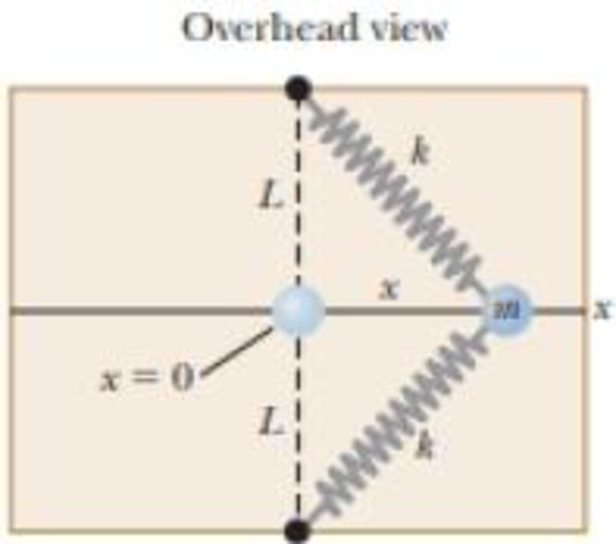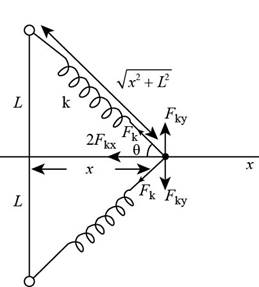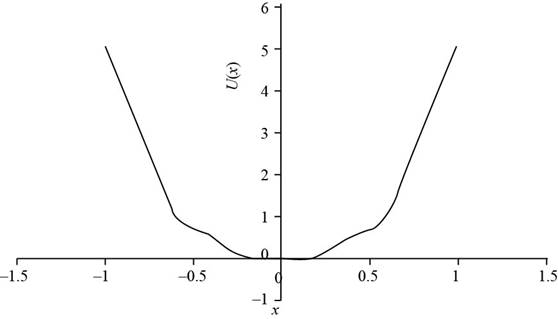
Concept explainers
A particle of mass m = 1.18 kg is attached between two identical springs on a frictionless, horizontal tabletop. Both springs have spring constant k and are initially unstressed, and the particle is at x = 0. (a) The particle is pulled a distance x along a direction perpendicular to the initial configuration of the springs as shown in Figure P7.50. Show that the force exerted by the springs on the particle is
(b) Show that the potential energy of the system is
(c) Make a plot of U(x) versus x and identify all equilibrium points. Assume L = 1.20 m and k = 40.0 N/m. (d) If the panicle is pulled 0.500 m to the right and then released, what is its speed when it reaches x = 0?
Figure P7.50

(a)
To show: The force exerted by the spring on the particle is
Answer to Problem 66CP
The force exerted by the spring on the particle is
Explanation of Solution
Given info: The mass of the particle is
The free body diagram of the given case is as shown in the figure below.

Figure (1)
The extension in the spring is,
Here,
The new length after stretching is,
Here,
Substitute
From the figure (1) the net force in
The net force in
The negative sign is due to the direction of the force in the negative direction.
Here,
From the free body diagram the value of
The formula for the spring force is,
Substitute
Substitute
Write the expression for the force exerted by the spring on the particle.
Substitute
Conclusion:
Therefore, the force exerted by the spring on the particle is
(b)
To show: The potential energy of the system is
Answer to Problem 66CP
The potential energy of the system is
Explanation of Solution
Given info: The mass of the particle is
From part (a) the force exerted by the spring on the particle is,
The potential energy of a system is,
Substitute
Conclusion:
Therefore, the potential energy of the system is
(c)
To draw: The plot of
Answer to Problem 66CP
The plot for

Explanation of Solution
Introduction:
The equilibrium points are the points at which the values of the force and the potential energy have the minimum value in order to have higher stability in the system.
Given info: The mass of the particle is
The potential energy of the system is,
Substitute
Thus, the potential energy of the system is,
The plot

Figure (2)
The equilibrium points are the point at the potential energy is zero. In the above plot the minimum potential energy is at
Form the graph the equilibrium point is for
Conclusion:
Therefore, the plot for
(d)
The speed of the particle.
Answer to Problem 66CP
The speed of the particle is
Explanation of Solution
Given info: The mass of the particle is
The potential energy of the system is,
Substitute
Thus, the potential energy of the system is
The potential energy is converted in to the kinetic energy to follow the law of conservation of momentum.
Here,
Rearrange the above equation for
Substitute
Conclusion:
Therefore, speed of the particle is
Want to see more full solutions like this?
Chapter 7 Solutions
Bundle: Physics for Scientists and Engineers with Modern Physics, Loose-leaf Version, 9th + WebAssign Printed Access Card, Multi-Term
Additional Science Textbook Solutions
College Physics: A Strategic Approach (3rd Edition)
Laboratory Manual For Human Anatomy & Physiology
SEELEY'S ANATOMY+PHYSIOLOGY
Fundamentals Of Thermodynamics
Chemistry: A Molecular Approach (4th Edition)
Chemistry & Chemical Reactivity
 Principles of Physics: A Calculus-Based TextPhysicsISBN:9781133104261Author:Raymond A. Serway, John W. JewettPublisher:Cengage Learning
Principles of Physics: A Calculus-Based TextPhysicsISBN:9781133104261Author:Raymond A. Serway, John W. JewettPublisher:Cengage Learning Physics for Scientists and Engineers: Foundations...PhysicsISBN:9781133939146Author:Katz, Debora M.Publisher:Cengage Learning
Physics for Scientists and Engineers: Foundations...PhysicsISBN:9781133939146Author:Katz, Debora M.Publisher:Cengage Learning Physics for Scientists and Engineers, Technology ...PhysicsISBN:9781305116399Author:Raymond A. Serway, John W. JewettPublisher:Cengage Learning
Physics for Scientists and Engineers, Technology ...PhysicsISBN:9781305116399Author:Raymond A. Serway, John W. JewettPublisher:Cengage Learning Physics for Scientists and Engineers with Modern ...PhysicsISBN:9781337553292Author:Raymond A. Serway, John W. JewettPublisher:Cengage Learning
Physics for Scientists and Engineers with Modern ...PhysicsISBN:9781337553292Author:Raymond A. Serway, John W. JewettPublisher:Cengage Learning University Physics Volume 1PhysicsISBN:9781938168277Author:William Moebs, Samuel J. Ling, Jeff SannyPublisher:OpenStax - Rice University
University Physics Volume 1PhysicsISBN:9781938168277Author:William Moebs, Samuel J. Ling, Jeff SannyPublisher:OpenStax - Rice University College PhysicsPhysicsISBN:9781285737027Author:Raymond A. Serway, Chris VuillePublisher:Cengage Learning
College PhysicsPhysicsISBN:9781285737027Author:Raymond A. Serway, Chris VuillePublisher:Cengage Learning





